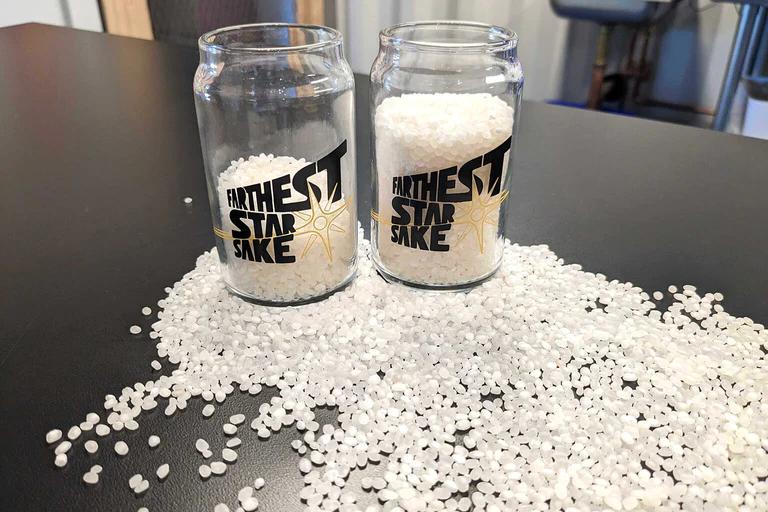Where: 525 Western Ave Brighton, MA 02135
Hours: 5 p.m. to 10 p.m. (Wed, Sun); 5 p.m. to 11 p.m. (Thurs-Sat)
From its NBA team to its pubs, Boston is a city known for its Irish. So when I sit down at the city’s first sake bar, The Koji Club, owner and founding member Alyssa Mikiko DiPasquale tells me that when she was young, she was unsure about how to connect with her Asian heritage.
“I grew up half Japanese in Massachusetts,” she says plainly. “I grew up closer to the Italian side of my family. There aren’t really any cultural touchpoints for a little Japanese girl here in Massachusetts.”
For a long time, that part of her identity remained elusive to her. But then the financial crisis of 2007-2008 hit, prompting her to leave her career in the art world and seek a new opportunity. It turned out to be one of the most fortuitous events of her life, as she took a job as a host — and eventual manager — of the high-end, world-renowned omakase restaurant, O Ya.
“They had just been voted the number one restaurant outside of New York City by The New York Times,” she recalls, “[and Chef Tim Cushman] had been named the best new chef in Food & Wine magazine. It was a lightning strike of incredible media coverage for them. I’ll never forget the sound of all three phone lines ringing off the hook.”
The excitement and excellence swirling about O Ya inspired, if not demanded that she learn more about Japanese cuisine and sake. Mikiko DiPasquale had finally found that cultural touchpoint she’d been missing.
“It was a rush that was both fulfilling in terms of me eating incredibly well, but also fulfilling because I was learning a lot about myself in a way that I hadn’t before. I love sake. I loved that sake brewers were coming to town, which wasn’t as frequent 15 years ago.”
What ended up inspiring her most was something she never expected.
“Some of them were my age,” Mikiko DiPasquale says of the brewers she met years ago. “And I guess in my brain, I was just picturing that these sake brewers on the other side of the world…I just kind of assumed that they were my grandpa’s age. And there are some [that age], and that is also lovely, but I was surprised. It felt like there was more meaning knowing that there were people my age on the other side of the world that were also engaging in the brewing, where I felt like I had more of a mission to share what they were doing because we were contemporaries trying to make a difference in the culinary and beverage world through this beverage that was so seriously misunderstood.”
“The only place you could go hang at a sake bar was New York City,” Mikiko DiPasquale laments of the past. “We were kind of organizing our lives, socially, around being able to go to New York to try new things and learn more, because the resources on the internet were finite. We had Timothy Sullivan doing the work, Beau Timken doing the work, and we were doing our best to study that way, but getting in the depths of Decibel and getting our hands on bottles and doing the studying that way was way more appealing, but something that we could not do here.”
So she changed that. Now, The Koji Club is the go-to spot for sake in Boston, and anyone who is culturally curious (or just tired of ordering Magners and Guinness every night) can also attend ticketed sake tastings on weekends to get to know Japan’s national beverage.
“I’d say that a majority of the guests — even 99% of the people that walk in here — are first-timers,” she says. “They feel like [the tastings are] the better entry point for them to then come and enjoy the bar; to come and learn privately in an intimate environment with someone who really knows their stuff. I’d say 99% of the people are coming in to, like, figure out what the beverage is all about. But that 1% of regulars is highly dedicated. The enthusiasm level from them is amazing.”
The Koji Club owner makes an extra effort to feature seasonal sake on the drink menu. When I visit her it’s spring, and the pink bottles on the shelf seem calm and inviting. It turns out that this, too, is another way to bridge the cultural gap between New England and Japan.
“New England is very much tied to seasons,” she says. “The only people who are more obsessed with the seasons than New Englanders are the Japanese. It makes sense to have a quarterly, seasonal menu. It makes sense for us also, so that we can cycle through things and try new things for our own education’s sake. We have a whole rosé section on the menu right now because it is rosé season for people in the wine world. So what better period of time to change people’s minds than to deliver them some sake that’s pink?”
In the evening I sit outside the bar, taking in the cool May breeze and a glass of “Wildflowers” Junmai by Aumont Shuzo (formerly Ichishima Shuzo), which kisses my palate with the gentle taste of sweet rice and honeysuckle. I wonder, with some optimism, about the future of sake in America and across the world. Perhaps one day, with the help of places like The Koji Club and Tippsy, this incredible beverage won’t seem so foreign and mysterious, and the little Japanese girls of tomorrow will feel more like they belong.













